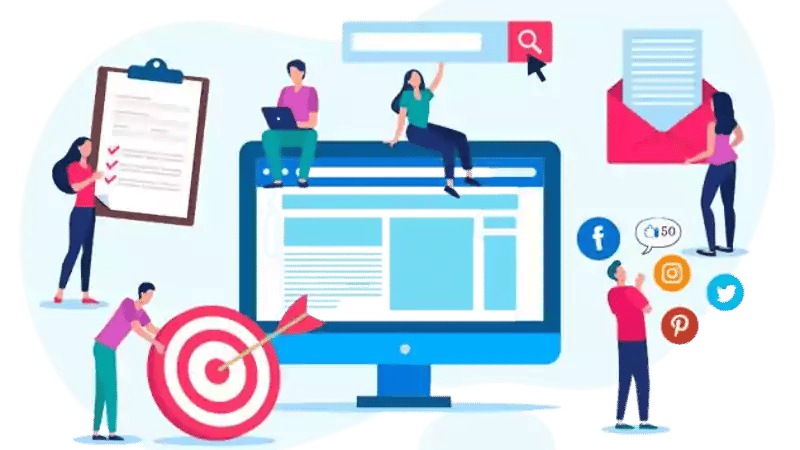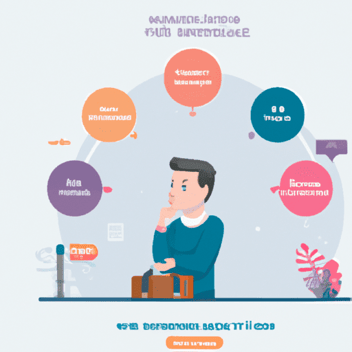Călătoria cumpărătorului: Conținut ideal pentru etapa de considerare
Imaginați-vă un client care face cumpărături... pentru produsul dumneavoastră! A recunoscut că are nevoie de o soluție, iar afacerea dvs. este una dintre posibilități. Dar cum există nenumărate opțiuni, cum îi determinați să intre în magazinul dvs. (sau să facă clic pe "adăugați la coș")?
Răspunsul: conținut special creat pentru etapa de analiză a parcursului cumpărătorului.

Înțelegerea parcursului cumpărătorului: Etapa de considerare
Etapa de analiză este punctul central al parcursului cumpărătorului, în care potențialii clienți își evaluează în mod activ opțiunile înainte de a lua o decizie de cumpărare. Spre deosebire de stadiul de conștientizare, în care indivizii se familiarizează cu o problemă, stadiul de analiză semnifică un nivel mai profund de implicare. Se caracterizează printr-un interes sporit pentru găsirea de soluții viabile și explorarea diferitelor produse sau servicii.
Importanța acestei etape constă în rolul său de punte între conștientizare și luarea deciziilor. Consumatorii fac cercetări detaliate în timpul etapei de analiză, căutând informații complete pentru a-și fundamenta alegerile. Crearea de conținut adaptat acestei etape devine imperativă, deoarece influențează în mod direct dacă un potențial client potențial progresează către conversie sau decide să exploreze opțiuni alternative.
Înțelegerea modului de gândire al cumpărătorilor aflați în etapa de analiză este esențială pentru crearea unui conținut care să rezoneze. În această etapă, consumatorii caută în mod activ soluții la problemele lor. Ei sunt dispuși să exploreze diverse opțiuni, să compare caracteristicile și să evalueze valoarea fiecărei soluții. Mentalitatea trece de la o conștientizare generală la o analiză mai concentrată a produselor sau serviciilor specifice care se aliniază nevoilor lor.
Rolul conținutului
În această etapă, consumatorii manifestă un nivel mai ridicat de implicare și intenție. Aceștia sunt dornici de informații aprofundate, căutând detalii dincolo de prezentarea generală de suprafață.
Ca atare, etapa de analiză necesită un conținut care să aibă un echilibru între informativ și persuasiv. Nu este vorba doar de a face consumatorii conștienți de ofertele dvs., ci de a-i ghida prin procesul de evaluare. Conținutul adaptat pentru această etapă ar trebui să furnizeze informații bazate pe valoare, să abordeze probleme specifice și să vă poziționeze produsul sau serviciul ca o alegere viabilă și superioară.
Cel mai bun conținut pentru etapa de analiză
1. Ghiduri și cărți albe aprofundate
În etapa de analiză, în care potențialii clienți caută în mod activ informații cuprinzătoare, ghidurile detaliate și whitepaper-urile sunt instrumente neprețuite. Aceste formate de conținut oferă oportunitatea de a aprofunda subiecte complexe, oferind o multitudine de informații dincolo de suprafață.
83% dintre cumpărătorii B2B spun că documentele albe le influențează deciziile de cumpărare.
Ghidurile aprofundate servesc drept foi de parcurs detaliate, ghidând consumatorii prin diverse aspecte ale produsului sau serviciului. Acestea pot include ghiduri practice, defalcări ale caracteristicilor și comparații cu soluții concurente. Pe de altă parte, whitepaper-urile adaugă un element de autoritate, prezentând date bine documentate, tendințe din industrie și analize ale experților. Împreună, acestea se adresează publicului avizat aflat în faza de analiză, satisfăcându-i setea de cunoaștere și ajutându-l să ia decizii în cunoștință de cauză.
2. Studii de caz care evidențiază succesul
Ființele umane sunt în mod inerent atrase de povești, iar în etapa de analiză, prezentarea unor povești de succes din viața reală prin studii de caz devine o strategie puternică. Aceste relatări oferă o legătură tangibilă cu produsul sau serviciul, demonstrând impactul acestuia în rezolvarea problemelor și obținerea de rezultate tangibile.
Potrivit Demand Gen, 96% dintre cumpărătorii B2B consideră esențial conținutul axat pe furnizor, precum studiile de caz și fișele tehnice ale produselor.
Studiile de caz aduc autenticitatea în prim plan, descriind modul în care oferta dvs. a influențat pozitiv alte persoane aflate în situații similare. Prin evidențierea provocărilor, a soluției implementate și a rezultatelor ulterioare, potențialii clienți obțin o înțelegere nuanțată a aplicațiilor practice și a eficienței produsului sau serviciului dumneavoastră. Această abordare personalizată a povestirii rezonează cu publicul din etapa de analiză, insuflând încredere în marca dvs.
3. Conținut interactiv: Chestionare, evaluări și sondaje
În era implicării digitale, conținutul interactiv a apărut ca o forță dinamică, în special în etapa de analiză. Chestionarele, evaluările și sondajele oferă un canal de comunicare bidirecțional, implicând activ potențialii clienți în procesul decizional.
Chestionarele oferă o modalitate atractivă de a ghida utilizatorii prin autodescoperire, ajutându-i să își înțeleagă nevoile și preferințele. Evaluările permit recomandări personalizate pe baza contribuțiilor utilizatorilor, adaptând informațiile la cerințele individuale. Sondajele, pe de altă parte, colectează feedback valoros, promovând un sentiment de colaborare între marcă și potențialul client.
Farmecul conținutului interactiv constă în capacitatea sa de a transforma procesul decizional într-un proces experiențial. Acesta captează atenția și asigură o participare activă, făcând etapa de analiză mai memorabilă și mai de impact. Prin încorporarea elementelor de gamificare, precum punctajul sau recompensele, conținutul interactiv transformă procesul decizional într-o experiență plăcută și informativă.
4. Articole pe blog
Blogurile din etapa de analiză joacă un rol crucial în furnizarea de informații și orientări detaliate. Spre deosebire de blogurile de sensibilizare care introduc concepte generale, blogurile de analiză se concentrează asupra unor aspecte specifice legate de procesul decizional. Acestea abordează întrebări și preocupări comune atunci când persoanele își analizează în mod activ opțiunile. Blogurile de analiză devin resurse educaționale, oferind informații valoroase care se aliniază nevoilor în evoluție ale publicului, făcând legătura între conștientizare și decizia finală.
92% dintre cumpărătorii B2B consultă cel puțin 3 site-uri web înainte de a face o achiziție. (Sursa: Demand Gen Report, 2022 B2B Buyer Behavior Survey)
Obiectivul este de a oferi potențialilor clienți informații care depășesc nivelul de suprafață, abordând preocupările lor specifice și contribuind activ la procesul lor decizional. Sarcina bloggerului este de a crea conținut care să atragă, să informeze și să convingă publicul să ia în serios ofertele mărcii.
Elemente-cheie care trebuie incluse într-un articol de blog din etapa de analiză:
-
Titluri de blog care atrag atenția: Crearea unor titluri convingătoare este poarta de acces către captarea atenției publicului. Titlurile de blog din etapa de analiză trebuie să fie intrigante, relevante și să stârnească curiozitatea cititorului. Aceste titluri servesc drept cârlig inițial, atrăgând vizitatorii să exploreze mai mult.
-
Adresați-vă întrebărilor frecvente: Conținutul din etapa de analiză ar trebui să acționeze ca o resursă informativă, răspunzând la întrebările pe care potențialii clienți le pun frecvent în această etapă. Conținutul se stabilește ca un ghid valoros prin abordarea acestor întrebări și ajutând cititorii să ia decizii în cunoștință de cauză.
-
Găsiți un echilibru între informare și persuasiune: Găsirea echilibrului corect între furnizarea de informații și încorporarea de elemente persuasive este esențială. În timp ce conținutul ar trebui să fie informativ și pătrunzător, acesta ar trebui, de asemenea, să convingă subtil cititorul să considere produsul sau serviciul mărcii drept o soluție viabilă.
Utilizarea cadrului "BARB" -Beneficii, alternative, riscuri și cele mai bune practici- poate fi utilă în această etapă. Abordarea beneficiilor produsului sau serviciului, prezentarea alternativelor, discutarea riscurilor potențiale și oferirea celor mai bune practici asigură o explorare bine închegată a considerentelor-cheie din blog.
Titluri de blog pentru etapa de analiză
Crearea titlurilor pentru etapa de analiză este o artă care necesită o înțelegere profundă a mentalității publicului. Titlurile trebuie să fie convingătoare, oferind o privire asupra informațiilor valoroase pe care le oferă blogul. Acestea trebuie să fie concise, dar puternice, să stârnească curiozitatea și să încurajeze cititorii să exploreze mai mult.
Includerea strategică a cuvintelor-cheie este vitală pentru îmbunătățirea vizibilității pe motoarele de căutare. Titlurile blogurilor din etapa de analiză ar trebui să includă cuvinte-cheie relevante care să se alinieze cu ceea ce potențialii clienți sunt susceptibili să caute. Această optimizare asigură faptul că conținutul este ușor de descoperit de către persoanele care caută în mod activ soluții.
Iată câteva exemple de titluri puternice pentru blogurile din etapa de analiză:
-
Titluri care abordează punctele dureroase și oferă soluții
-
Frustrat de [Problema]? Iată cum să o depășiți în cele din urmă
-
Vă simțiți copleșiți de [alegere]? Acest ghid o face mai ușoară
-
Nu sunteți sigur dacă [Produsul/Serviciul] este potrivit pentru dumneavoastră? Citiți asta mai întâi.
-
-
Titluri care utilizează cifre și date pentru a crea încredere
-
5 moduri dovedite de a [atinge obiectivul] în doar [termen]
-
Statisticile nu mint: de ce ar trebui să luați în considerare [produsul/serviciul]
-
Top 3 alternative la [concurent] pentru [public țintă]
-
-
Titluri care utilizează dovezi sociale și mărturii
-
Secretul [succesului] despre care nimeni nu vorbește (dar pe care trebuie să îl știți)
-
Acest singur truc ți-ar putea schimba [viața/ afacerea] pentru totdeauna
-
Ceea ce nu știți despre [subiect] v-ar putea costa scump
-
-
Titluri care stârnesc curiozitatea și intriga
-
Studiu de caz: Cum [compania] a obținut [rezultate] cu [produs/serviciu]
-
Vedeți de ce acești experți recomandă [produsul/serviciul]
-
-
Titluri care sunt specifice și orientate spre acțiune
-
Sunteți gata să vă lansați afacerea? Obțineți acum lista dvs. de verificare gratuită
-
Descărcați Ghidul nostru pentru alegerea [produsului/serviciului] potrivit
-
Ofertă limitată în timp: Încercați [Produs/Serviciu] fără risc timp de 30 de zile
-
Sfaturi bonus:
- Păstrați-vă titlurile concise, ideal sub 70 de caractere.
- Utilizați cuvinte-cheie relevante pentru publicul țintă și pentru SEO.
- Creați un sentiment de urgență sau exclusivitate pentru a încuraja clicurile.
- Testați titluri diferite pentru a vedea care rezonează cel mai bine cu publicul dumneavoastră.
Deși fiecare tip de conținut are puncte forte unice, o abordare holistică a creării de conținut în etapa de analiză implică adesea combinarea acestor elemente. Ghidurile aprofundate și cărțile albe oferă profunzimea și detaliile necesare, studiile de caz adaugă o notă umană cu exemple din lumea reală, iar conținutul interactiv insuflă un sentiment de angajament și participare.
Îmbinând aceste tipuri de conținut într-o strategie coerentă, comercianții pot răspunde preferințelor diverse ale potențialilor clienți aflați în etapa de analiză. Această abordare cuprinzătoare educă și hrănește clienții potențiali, ghidându-i spre faza finală de luare a deciziilor cu o mentalitate bine informată și implicată.
Întrebări pe care le pun potențialii dvs. clienți în etapa de analiză
1. "Care sunt principalele caracteristici ale produsului sau serviciului dumneavoastră?"
Prospecții doresc o defalcare detaliată a caracteristicilor pe care le oferă oferta dvs. pentru a evalua cât de bine se aliniază cu nevoile lor.
2. "Cum se compară produsul dvs. cu concurenții de pe piață?"
Perspectivele comparative ajută prospecții să înțeleagă ce diferențiază produsul dvs. și de ce ar putea fi alegerea superioară.
3. "Puteți oferi exemple din lumea reală sau studii de caz ale implementărilor de succes?"
Studiile de caz oferă dovezi tangibile ale eficacității produsului dvs. și oferă o imagine a aplicațiilor sale practice.
4. "Ce beneficii voi obține alegând soluția dumneavoastră?"
Prospecții caută să înțeleagă clar avantajele specifice și propunerile de valoare pe care le aduce produsul sau serviciul dumneavoastră.
5. "Există diferite planuri tarifare sau opțiuni disponibile?"
Claritatea privind structurile de tarifare asigură faptul că prospecții pot evalua aspectul financiar al deciziei lor și pot alege un plan care se potrivește bugetului lor.
6. "Cum este asistența pentru clienți și serviciile postcumpărare?"
Întrebările privind asistența pentru clienți și serviciile postcumpărare indică preocupările prospecților cu privire la satisfacția și asistența pe termen lung.
7. "Oferiți un test sau o demonstrație pentru a experimenta produsul/serviciul dvs. direct?"
O experiență practică este adesea căutată pentru a evalua capacitatea de utilizare a produsului și adecvarea la nevoile lor specifice.
8. "Puteți oferi mărturii de la clienți actuali sau din trecut?"
Mărturiile adaugă credibilitate și oferă o dovadă socială, ajutând potențialii clienți să aibă încredere în marca și oferta dvs.
9. "Ce integrări sau opțiuni de compatibilitate are produsul/serviciul dvs.?"
Prospecții doresc să se asigure de o integrare perfectă cu instrumentele și sistemele lor existente, minimizând întreruperile.
10. "Cum contribuie produsul dvs. la rezolvarea provocărilor mele specifice?"
Adaptați-vă răspunsurile pentru a aborda provocările unice ale prospectului, prezentând modul în care soluția dvs. se potrivește nevoilor lor.
Ghid pas cu pas pentru crearea de conținut pentru etapa de analiză
-
Înțelege-ți publicul. Începeți prin a înțelege nevoile, punctele nevralgice și preferințele publicului dvs. țintă în etapa de analiză. Efectuați cercetări amănunțite pentru a identifica întrebările și preocupările specifice ale acestora în timp ce analizează diverse opțiuni.

-
Definiți subiectele-cheie. După ce ați înțeles în mod clar publicul dumneavoastră, prezentați subiectele-cheie care se aliniază cu considerațiile tipice acestei etape. Acestea ar putea include caracteristici detaliate ale produsului/serviciului, comparații cu concurenții, povești de succes și orice alte informații relevante care ajută la luarea deciziei.
-
Creați titluri care să atragă atenția. Începeți crearea conținutului cu titluri care atrag atenția. Acestea ar trebui să fie convingătoare și să indice valoarea pe care o oferă conținutul dumneavoastră. Luați în considerare utilizarea unui limbaj care să rezoneze cu curiozitatea publicului și să sublinieze beneficiile pe care le caută.
-
Adresați-vă întrebărilor frecvente. Dezvoltă-ți conținutul pentru a răspunde direct întrebărilor frecvente ale publicului tău și preocupărilor din timpul etapei de analiză. Oferiți răspunsuri clare, concise, care oferă informații valoroase și vă prezintă brandul ca o sursă cu autoritate în industrie.
-
Găsiți un echilibru între informare și persuasiune. Găsiți un echilibru delicat între furnizarea de conținut informativ și încorporarea de elemente persuasive. În timp ce informațiile ar trebui să fie complete și imparțiale, utilizați un limbaj persuasiv care să îndrume subtil cititorul să considere produsul sau serviciul dvs. drept o soluție viabilă.
-
Utilizați diverse formate de conținut. Diversificați-vă conținutul prin încorporarea unor formate diferite, cum ar fi ghiduri detaliate, studii de caz, elemente interactive precum chestionare sau evaluări și articole de blog bine elaborate. Formatele diferite răspund preferințelor variate, asigurând o abordare mai atractivă și mai cuprinzătoare.
-
Optimizați pentru motoarele de căutare. Încorporați în mod natural cuvinte-cheie relevante în conținutul dvs. pentru a-i spori vizibilitatea pe motoarele de căutare. Acest lucru asigură faptul că conținutul dvs. ajunge la potențialii clienți care caută în mod activ informații în timpul etapei de analiză.
-
Promovați implicarea utilizatorilor - favorizați implicarea prin încurajarea comentariilor, a întrebărilor și a partajării conținutului dvs. Participați activ la discuții pentru a răspunde întrebărilor ulterioare și pentru a crea o comunitate în jurul mărcii dvs.
Urmând acest ghid pas cu pas, puteți crea conținut personalizat pentru etapa de analiză. Această abordare strategică îi ajută pe potențialii clienți să ia decizii în cunoștință de cauză și vă poziționează brandul ca o resursă de încredere și valoroasă pe tot parcursul procesului lor decizional.
Ghidarea strategică a consumatorilor prin etapa de analiză
A doua etapă din călătoria cumpărătorului este esențială, făcând tranziția potențialilor clienți de la conștientizare la decizie. Această tranziție ghidată implică crearea de conținut care informează și influențează, punând bazele oportunităților de conversie. Articolele informative de pe blog, documentele tehnice detaliate și studiile de caz sunt modalități excelente de a continua educarea potențialilor clienți cu privire la soluția dvs. Încă nu vă vindeți produsul în întregime, dar continuați să vă demonstrați valoarea și să îl oferiți ca soluție la problemele clienților.
Prin integrarea acestor elemente de conținut strategic în strategia dvs. de inbound marketing, puteți crea conexiuni durabile (care, sperăm, conduc la conversii).
Odată ce ați trecut cu bine de etapa de analiză, este timpul să vă pregătiți pentru etapa finală a călătoriei cumpărătorului: decizia.
Acest conținut este disponibil și în:
- Germană: Die Buyer's Journey: Inhalte für die Consideration-Phase
- Engleză: The Buyer's Journey: Best Content for the Consideration Stage
- Spaniolă: El buyer journey: El mejor contenido para la etapa de consideración
- Franceză: Le parcours de l'acheteur : Contenu pour l'étape de la considération
- Italiană: Buyer's Journey: i contenuti ideali per la fase di considerazione
- Chineză: 买家之旅:考虑阶段的最佳内容









Lasă un comentariu cu părerea ta.